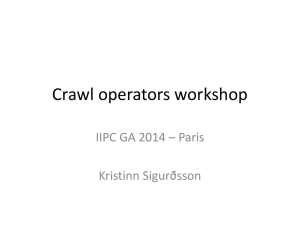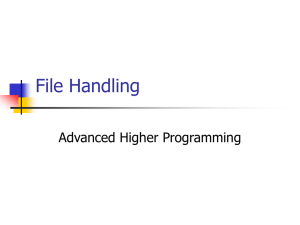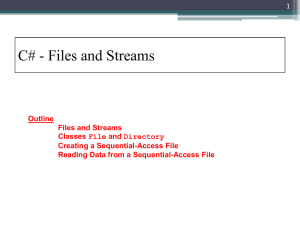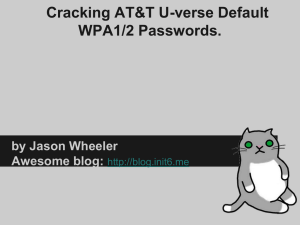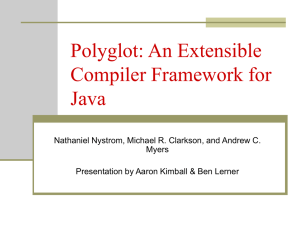Input Sanitization
advertisement
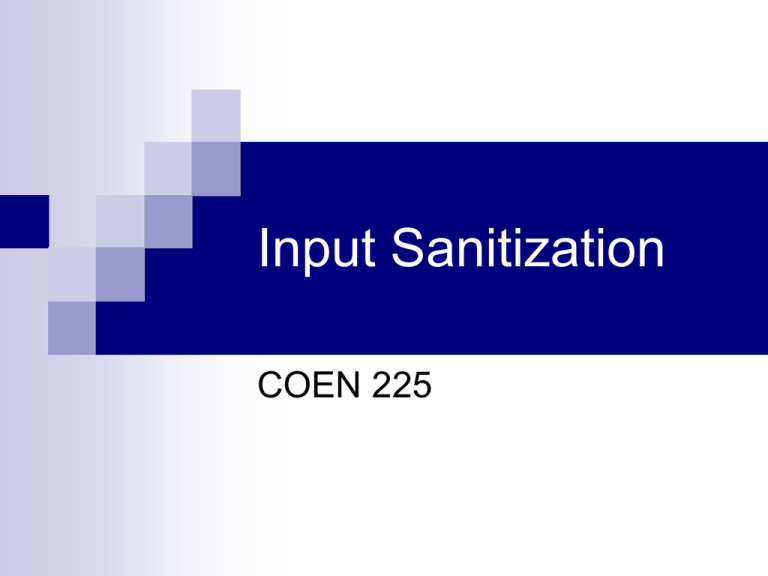
Input Sanitization
COEN 225
All Input is Evil
All input is evil:
At
least potentially
Input can be: (A random collection)
Files
Web forms
Cookies
Registry entries
Database contents
Command line arguments
Environmental
variables
HTTP requests
Named pipes
E-mail
…
Finding Common Entry Points
Files
Contain
data specified by users
Contain data supplied by application
Can be intentionally or unintentionally corrupted
Attacker can also attack file metadata:
Extension
Path
File system attributes
…
Finding Common Entry Points
Sockets
Easy
to connect to sockets need to filter
data
Attacker can
Monitor data
Send malformed data to client or to server
Intercept data in the middle of a request and
replace it
A.k.a Man in the middle attack
Finding Common Entry Points
HTTP requests
Almost
always passes through firewalls
Using webproxy, users have complete control over
what is send to the server
Named pipes
See
sockets
But programmers might forget how named pipes work
and trust input
E.g. SQL Server 2000 vulnerability
See http://www.blakewatts.com/namedpipepaper.html
Finding Common Entry Points
Pluggable Protocol Handler
Example:
http, ftp, https in URL
mailto:tschwarz@scu.edu?subject=WrongPerson
Tell
system which application handles data when a
hyperlink is clicked
Maliciously crafted link irc://[~900 characters] caused
buffer overflow in mIRC protocol handler that allowed
arbitrary code execution
Finding Common Entry Points
Programmatic Interfaces
RPC
COM
DCOM
ActiveX
Managed
code entry points (Windows)
.NET Remoting
Finding Common Entry Points
SQL
Improperly
filtered input strings can lead to
execution of powerful SQL commands
Registry
User Interfaces
Win95
machines were used in libraries
Attacker could remove the “Start” button for
free entertainment
Finding Common Entry Points
Command line arguments
Attacker
provides helpful link with arguments
embedded
Example: Cross scripting attacks
Environmental Variables
Can
be used by programs to make decisions
Canonicalization
Authentication decision made by one
module
Access done by other module
Input Validation
Input – Anything controlled by outsider
user
command line input
configuration files that could be manipulated
http requests
packets under consideration by firewall
…
Input Validation
Security Strategies
Black List
List all things that are NOT allowed
List is difficult to create
Adding insecure constructs on a continuous basis means
that the previous version was unsafe
Testing is based on known attacks.
List from others might not be trustworthy.
White List
List of things that are allowed
List might be incomplete and disallow good content
Adding exceptions on a continuous basis does not imply
security holes in previous versions.
Testing can be based on known attacks.
List from others can be trusted if source can be trusted.
Input Validation
Principle problem
Location
of Check Location of Use
Principle solution
Canonicalization
of input
Transform input into a canonical form
Decision
is made on input in the same form
that program uses
Canonicalization
Two major program errors:
Misunderstanding
definition of canonical form
Stopping canonicalization process to early
Canonicalization:
Dealing with Metacharacters
Meta-information can be attached
Out-Of-Band
In-Band
Often more readable
Often more compact
Has security implications
Potential for overlapping trust domains:
There exists a logical boundary between data and
metadata
Parser need to identify the difference between data
and metadata correctly
Canonicalization:
Dealing with Metacharacters
Example: NULL character for termination
of strings
Canonicalization:
Dealing with Metacharacters
Simplest Vulnerability:
Users
can embed metacharacters into input
that is not filtered
Instance of second-order injection attack
The attack happens when the metacharacter is
evaluated
Example:
Password update (next slide)
Canonicalization:
Dealing with Metacharacters
No input
use CGI;
sanitization!
… verify session details …
$new_password = $query->param(′password′);
open(IFH,″</opt/passwords.txt″) || die (″$!″);
User bob inputs:
open(OFH,″>/opt/passwords.txt.tmp″) || die (″$!″); test\njim:npwd
while(IFH)
{
($user, $pass) = split /:/;
if ($user ne $session_username)
OFH becomes:
print OFH ″$user:$pass\n″;
bob:test
else
jim:npwd
print OFH ″$user:$new_password\n″;
}
…
Bob just added a
close( IFH );
new user
close( OFH );
Canonicalization:
Dealing with Metacharacters
Discovering attacks like this:
1.
2.
3.
4.
5.
Identify code that deals with metacharacter strings
Identify all delimiter characters that are specially
handled and put them into a list
Identify filtering performed on input
Eliminate potentially hazardous delimiter characters
from list
Remaining characters on list indicate a vulnerability
Canonicalization:
Dealing with Metacharacters
Bool HandleUploadedFile(char * filename)
{
unsigned char buf[MAX_PATH], pathname[MAX_PATH];
char * fname = filename, *tmp1, *tmp2;
DWORD rc;
HANDLE hFile;
tmp1 = strrchr(filename,′/′);
tmp2 = strrchr(filename,′\\′);
if(tmp1||tmp2) fname = (tmp1 > tmp2? tmp1 : tmp2)+1;
if(!fname) return FALSE;
if(strstr(fname, ″.. ″)) return FALSE;
_snprintf(buf, sizeof(buf), ″\\\\?\\%TEMP%\\%s″,fname);
rc = ExpandEnvironmentStrings(buf, pathname, sizeof(pathname));
if(rc == 0 || rc > sizeof(pathname)) return FALSE;
hFile = CreateFile(pathname, …);
… read bytes into the file …
}
1 Input string is formatted a number of ways before it becomes a file
name.
Added to a statically sized buffer and prefixed with \\\\?\\%TEMP%\\
Canonicalization:
Dealing with Metacharacters
Bool HandleUploadedFile(char * filename)
{
unsigned char buf[MAX_PATH], pathname[MAX_PATH];
char * fname = filename, *tmp1, *tmp2;
DWORD rc;
HANDLE hFile;
tmp1 = strrchr(filename,′/′);
tmp2 = strrchr(filename,′\\′);
if(tmp1||tmp2) fname = (tmp1 > tmp2? tmp1 : tmp2)+1;
if(!fname) return FALSE;
if(strstr(fname, ″.. ″)) return FALSE;
_snprintf(buf, sizeof(buf), ″\\\\?\\%TEMP%\\%s″,fname);
rc = ExpandEnvironmentStrings(buf, pathname, sizeof(pathname));
if(rc == 0 || rc > sizeof(pathname)) return FALSE;
hFile = CreateFile(pathname, …);
… read bytes into the file …
}
2 Set of delimiter characters that are specially handled:
‘/’ ‘\’ “..”
String is passed to Expand EnvironmentStrings( ).
Environmental variables are denoted with % characters.
Canonicalization:
Dealing with Metacharacters
Bool HandleUploadedFile(char * filename)
{
unsigned char buf[MAX_PATH], pathname[MAX_PATH];
char * fname = filename, *tmp1, *tmp2;
DWORD rc;
HANDLE hFile;
tmp1 = strrchr(filename,′/′);
tmp2 = strrchr(filename,′\\′);
if(tmp1||tmp2) fname = (tmp1 > tmp2? tmp1 : tmp2)+1;
if(!fname) return FALSE;
if(strstr(fname, ″.. ″)) return FALSE;
_snprintf(buf, sizeof(buf), ″\\\\?\\%TEMP%\\%s″,fname);
rc = ExpandEnvironmentStrings(buf, pathname, sizeof(pathname));
if(rc == 0 || rc > sizeof(pathname)) return FALSE;
hFile = CreateFile(pathname, …);
… read bytes into the file …
}
3 Set of delimiter characters that are specially handled:
‘/’ ‘\’ “..”
String is passed to Expand EnvironmentStrings( ).
Environmental variables are denoted with % characters.
Canonicalization:
Dealing with Metacharacters
Bool HandleUploadedFile(char * filename)
{
unsigned char buf[MAX_PATH], pathname[MAX_PATH];
char * fname = filename, *tmp1, *tmp2;
DWORD rc;
HANDLE hFile;
tmp1 = strrchr(filename,′/′);
tmp2 = strrchr(filename,′\\′);
if(tmp1||tmp2) fname = (tmp1 > tmp2? tmp1 : tmp2)+1;
if(!fname) return FALSE;
if(strstr(fname, ″.. ″)) return FALSE;
_snprintf(buf, sizeof(buf), ″\\\\?\\%TEMP%\\%s″,fname);
rc = ExpandEnvironmentStrings(buf, pathname, sizeof(pathname));
if(rc == 0 || rc > sizeof(pathname)) return FALSE;
hFile = CreateFile(pathname, …);
… read bytes into the file …
}
4 Filtering:
strrchr searches last occurrence for ‘/’ and ‘\’ and increments past it.
strstr searches for “..”
Canonicalization:
Dealing with Metacharacters
Bool HandleUploadedFile(char * filename)
{
unsigned char buf[MAX_PATH], pathname[MAX_PATH];
char * fname = filename, *tmp1, *tmp2;
DWORD rc;
HANDLE hFile;
tmp1 = strrchr(filename,′/′);
tmp2 = strrchr(filename,′\\′);
if(tmp1||tmp2) fname = (tmp1 > tmp2? tmp1 : tmp2)+1;
if(!fname) return FALSE;
if(strstr(fname, ″.. ″)) return FALSE;
_snprintf(buf, sizeof(buf), ″\\\\?\\%TEMP%\\%s″,fname);
rc = ExpandEnvironmentStrings(buf, pathname, sizeof(pathname));
if(rc == 0 || rc > sizeof(pathname)) return FALSE;
hFile = CreateFile(pathname, …);
… read bytes into the file …
}
5 However, ‘%’ remains
Client can supply a number of environmental variables such as
QUERY_STRING
In addition, something like
..\..\..\any\pathname\file.txt supplied in
QUERY_STRING allows client to write to arbitrary locations in the file system
Canonicalization:
Dealing with Metacharacters
open(FH,
″>$username.txt″)
NULL character
injection
|| die(″$!″);
print are
FH necessary
$data;
NULL characters
to terminate strings when
calling C routines
from OS and many APIs
close(FH);
Perl and other languages do not use NULL for termination
Example:
Perl application programmer tests that file name ends in “.txt”
Attack inputs sequence “%00” in CGI input
Decoded as NUL character
Can be used to cut-off filename, including extension
Canonicalization:
Dealing with Metacharacters: NULL
NUL metacharacter is used to end Cstrings, but not Perl, Java, PHP, …
This
is a canonicalization issue:
C-based modules canonicalize strings differently
than the no-C/no-Unix world
Issues
arise when strings cross boundaries
between these worlds
Canonicalization:
Dealing with Metacharacters: NULL
Possible results:
Memory
corruption because strlen returns a
different value
Truncation of strings False decisions
Especially for FILE NAMES
B O B . T X T \0
B O B \0 . T X T \0
Path Metacharacters
Windows File Names:
C:\\WINDOWS\system32\calc.exe
Optional device
Followed by path
NOT UNIQUE
C:\\WINDOWS\system32\drivers\..\calc.exe
calc.exe
.\calc.exe
..\calc.exe
\\?\WINDOWS\systems32\calc.exe
File system uses file canonicalization
But the system is less than canonical
Path Metacharacters
Issues:
File squatting (in Windows)
Need to use CreateFile carefully in order to
CreateFile canonicalization
Not open an existing file that sits in the canonical path of the file name
eliminates any directory traversal components before validating whether
each path segment exists
C:\nonexistent\path\..\..\blah.txt accesses C:\blah.txt
File-like Objects
CreateFile can open objects that are treated like files but are not files:
\\host\object
type\name
Device Files
Reside in the file hierarchy
But are canonicalized differently
COM!-9, LPT1-9, CON, CONIN$, CONOUT$, PRN, AUX, CLOCK$, NUL
Programmers are often not aware of the rules
Path Metacharacters
CreateFile() (Windows) idiosyncrasies
Strips out trailing spaces in file names
Example attack
Case Sensitivity
Windows filenames are not case sensitive, UNIX and HFS filenames are
DOS 8.3
Programmer attaches “.txt” to a user-provided name
Attacker provides “helloworld.exe “ with trailing space
The trailing space with following .txt is stripped out
Short file name is created by the file system if the file name is too long.
File can be referred to by the short file name
Use \\?\ before file name to disable DOS filename parsing
Insure that files are normal files by checking for
FILE_ATTRIBUTE_NORMAL, or face access to named pipes, …
Alternative Data Streams are created with an “:” separator
Path Metacharacters
Registry keys
Naming
similar to files
Similar issues
Worthy of its own presentation
Canonicalization:
Dealing with Metacharacters
Shell Metacharacter Injection
Attack
vector
User controls input to an argument for execve(),
popen(), …
Dangerous
shell characters
; | & < > ` ! - * / ? ( ) . [space] [ ] “\t” ^ ~ \ “\\”
quotes “\r” “\n” $
Canonicalization:
Dealing with Metacharacters
SQL Injection attack
Attack
vector:
User controls part of the SQL query string
Canonicalization
Meta Character Filtering
Three basic options
Detect erroneous input and reject what
appears to be an attack
2. Detect and strip dangerous characters
3. Detect and encode dangerous characters
with a metacharacter escape sequence
1.
Canonicalization
Meta Character Filtering
Eliminating Metacharacters
Whitelisting: Allow only good strings
if($input_data =~ /[^A-Za-z0-9_ ]/) {
exit;
}
Whitelisting: Strip away anything that is not good
$input_data =~ s/ /[^A-Za-z0-9]/g
Stripping is vulnerable to mistakes
Blacklisting:
Make decisions based on dangerous
characters (not recommended)
Canonicalization
Meta Character Filtering
Escaping Metacharacters
Non-destructive:
metacharacters are
preserved in string
Goal: Receiving module receives a safe string
Attack vectors:
Metacharacter evasion
Encoded metacharacter can be used to avoid other
filtering
Canonicalization
Meta Character Filtering
Escaping Metacharacters
Filtering
does not detect encoded
dXNlcj1wYXNzd2QmaG9tZWRpcj0uLiUyNSUzMiU0Ni4uJTL1JTMyJTQ
metacharacters
Base 64 Decoder
Example: ..%2F..%2Fetc%2Fpasswd
user=passwd&homedir=..%25%32%46..%25%32%46etc
Double
Encoding
Attacks
Hexadecimal Decoder
pass 1
user=passwd&homedir=..%2F..%2Fetc
Hexadecimal Decoder pass 1
user=passwd&homedir=../../etc
Canonicalization
Meta Character Filtering
Character Sets
Example vulnerabilities
Wide characters (unicode) C-style strings are terminated with
a 16 NULL, normal character strings with an 8 NULL
Homographic attacks
Different characters look the same
String
“Microsoft” “Microsoft” in Unicode
one ‘o’ is cyrillic
length calculations need to take character set
into account (wide characters vs. normal characters)
